The last Kiwanos
This week: Joining the dots; Some housekeeping; FutureLearn; Just a small leak; The last Kiwanos;
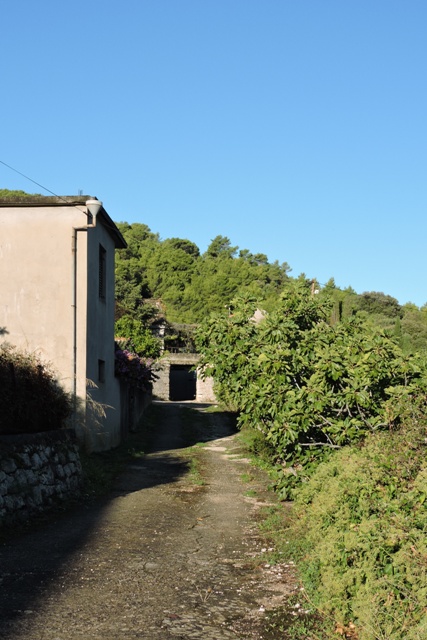
We are well into the autumn transition now. The leaves are falling from my big, old Myrobalan plum, littering the ground with small bronze leaves.
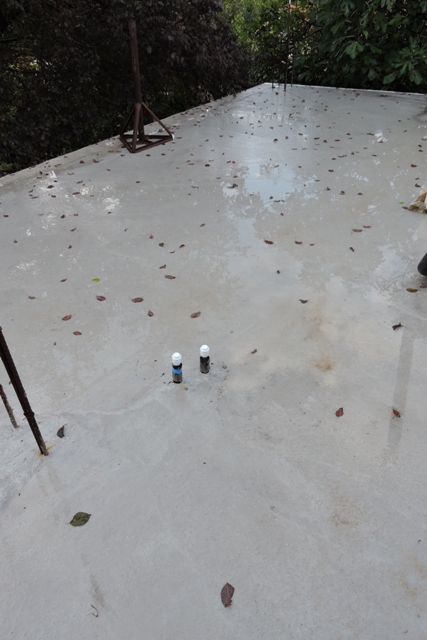
This is the first tree on my land to burst into leaf in the spring, and the first to have bare branches in autumn.
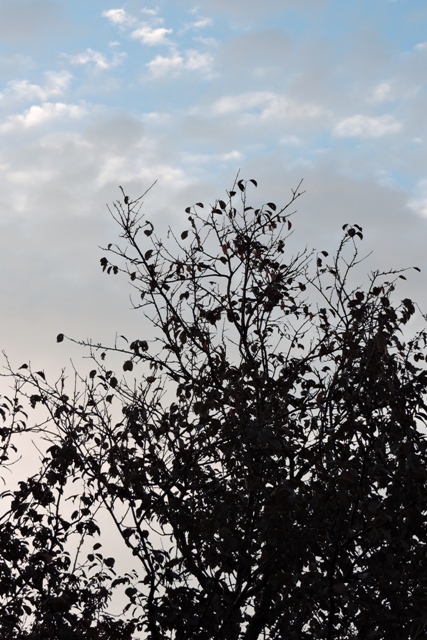
From a distance, the leaves don’t seem to assume any autumn colour as the abscission process happens, they retain their bronze colour and fall to the ground.
However close up, you can see there are changes taking place as the leaf veins shut down, but they don’t take on the radiant hues of other deciduous trees.
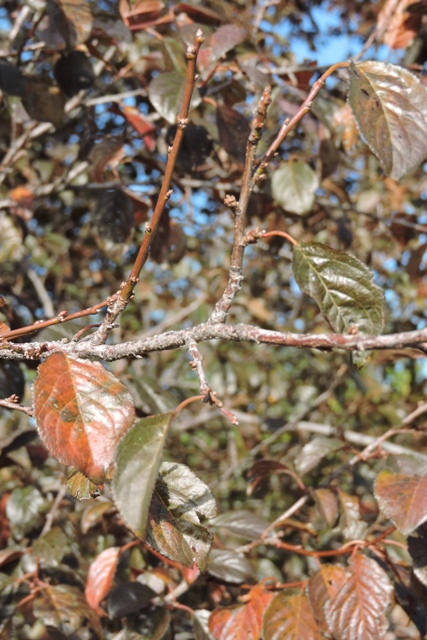
It is also the time of year when the ground starts to remain moist for longer. After the pulses of rain at the end of September, I have been able to cease having to irrigate.
Rain also means that the dry, dusty conditions we have experienced since late April have abated.
I had a day off on Tuesday when a retired West Yorkshire colleague who lives is Gradac called. He brought some nice gifts with him and we enjoyed a convivial lunch.
With rain on Wednesday, I was able to do some inside jobs without feeling guilty.
However the driving rain seeped in between the new concrete workshop ceiling and the century old wall. Another job to do!
Then the sun came out for the rest of the week.
Joining the dots
I had decided to work on the central heating this week. Not because I am planning on firing up the system soon, rather doing it at my pace on warm, sunny days rather than in a rush when it does become cold is the sensible thing to do.
First up I dug out the plans of the new building together with photos I took during the installation.
With modern digital cameras, I photograph almost every thing I do, so that I have an instant record to refer back to. Photographs are all backed up too, just in case…
I had used a permanent marker to write on the heating pipes and/or the insulation, where they were hot or cold, and just for good measure, I also used red and blue electrical tape round pipes.
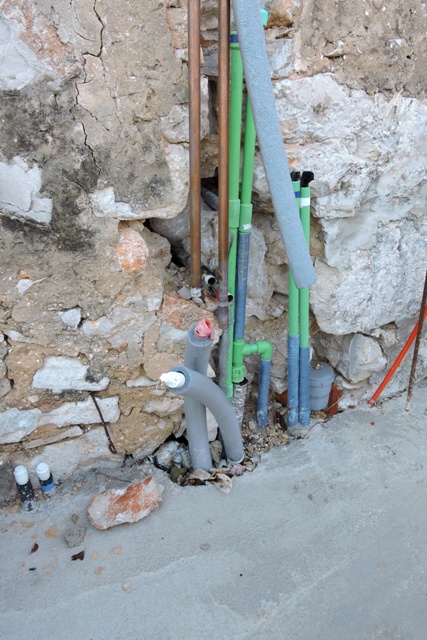
This is the point where all services converge and emerge. They will be in the wall when the lounge is built.
Where pipes come through the concrete, they are all encased in insulation and then capped with more tape, as a temporary barrier. I am using HEP₂0 pipe work throughout.
This is a new generation pipework with a 50 year guarantee. 28 mm pipes start at where the Integrated Thermal Store will be placed, these then branch to 15 mm pipes for radiators in the workshop, then divide into two.
The ground floor branch continues using 28 mm pipes into the large Konoba, and the branch up to the first floor continues as 28 mm pipe to the loft.
At various locations there are further 22 mm reducing branches, which eventually become 15 mm plastic leads to the locations of the radiators. One singular advantage of HEP₂0 is that you can connect copper pipes into the plastic joints. So the tails that lead up to the radiators are traditional copper pipes.
With no ground floor radiator connections, I needed to blank off the various pipes. There will be water in them, but it will not be circulating. I decided that to include shut off valves into the system would be an unnecessary expense and that I could achieve the same result with end caps.
Last orders!
First job was to connect the hot feed and cold return pipe from the wood stove boiler that had been cut when the building work was in process. I polished the copper pipes with Solvol Autosol metal polish, then fitted thick insulation, before slipping on the HEP₂0 connectors.
It was an easy task to then cut some short lengths of pipe and join the system up to the pipes into the new building.
Starting with the ground floor pipes, I charged them with water and then fitted caps to the various radiator pipes.
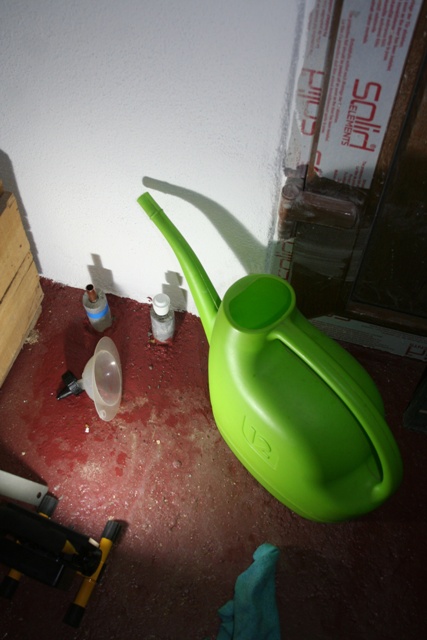
For the present and until more building work is done, there will be no hot water circulation in this area so charging the pipes then sealing them meant air in the system is removed.
The pipe run at first floor level is more complicated. There are the pipes for radiators ready for when the lounge is built, but also where the services run into the bedroom/bathroom/study part of the building.
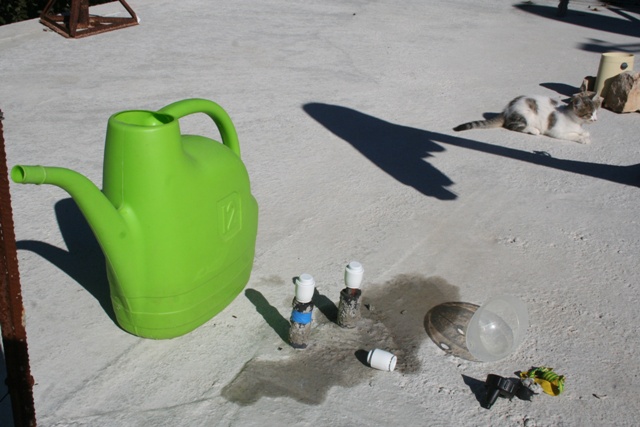
After seventeen frozen copper pipes burst in January 2017 I replaced them with HEP₂0, which I joined onto copper that hadn’t failed.

I now needed to make new and more permanent connections. This is a 28 mm pipe link to the loft expansion tank, but it will become the radiator feed into the loft in due course.
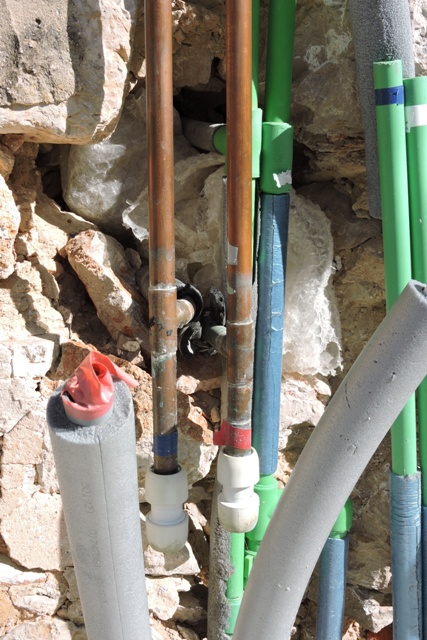
I discovered that the so called “plumber” who had installed the copper, had stuffed a hole in the wall with bubble wrap and then had added a few stones to mask what he had done.
Clearly he is a fully paid up member of that well known tradesmen’s organisation Bodgeit, Dodgeit & Scarper!
It was a full day’s work to remove some stone from the old wall – just enough to make access easy – then cutting the copper pipe and finally preparing the HEP₂0 pipework and making the connections.
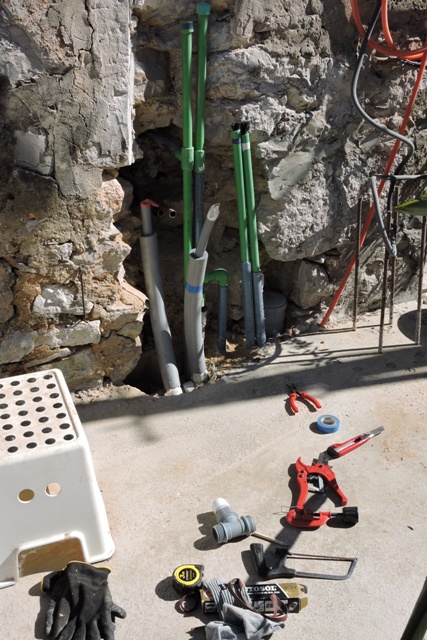
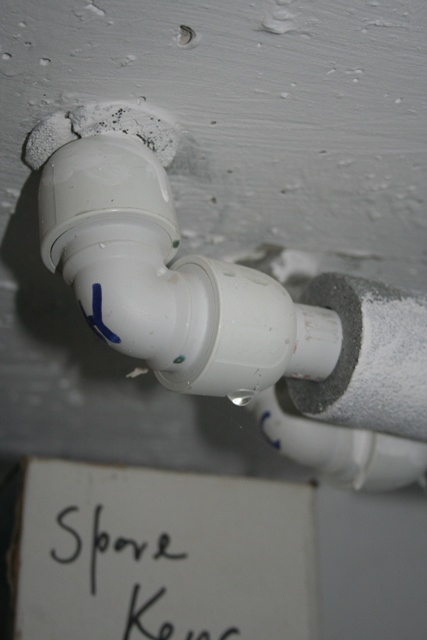
With the ground floor and first floor pipes all charged with water, I then went round to check for any weeping joints. Out of the more than 16 unions, there was just one where there was an ever so slight weep.
Using a Boa Constrictor tool – rubber on plastic grips without harming the pipe – I tightened up the HEP₂0 into the 90º union. The weeping ceased!
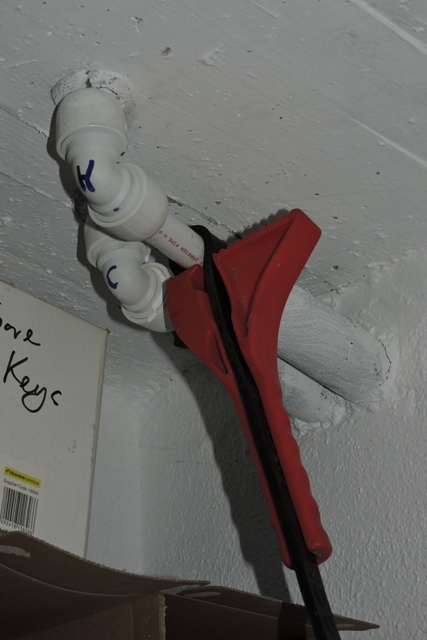
I have ordered some corrosion inhibitor from the local plumbers merchant. It’s not a stock item (?!) so will be here next week. I can then fill these pipes and close the final joints and I am ready for winter….
Some housekeeping
The return of damp weather means that the amount of blowing dust has been reduced to zero.
With a sand courtyard, even with a coconut mat in front of every door, it is impossible to prevent sand coming into the buildings.
Just moving the mats reveals the amount that they intercept.
Not forgetting my felines, who like to have a good roll in the sand. Then they come indoors and just a small shake deposits the fine sand onto the tiles or mats – I don’t have any carpets!
I also generally keep doors and windows open all summer to allow air flow with just insect screens. Whist the nylon mesh screens are very good at keeping the insects a bay, the sand, as fine as talcum powder, just blows through.
It’s usual to do an annual “spring clean”, but I also do an “autumn clean” to get ready for the winter. This week I’ve done it and everywhere looks better.
One of the other equally important housekeeping tasks is to backup files from the computer onto external hard drives.
I have a couple of 1TB USB3 drives where I keep my data backups. As it was a rainy miserable morning on Wednesday, even though still mild, I took the opportunity to backup all the photographs and documents from the desktop hard drive, onto the two external devices to keep specially for the purpose.
One external hard drive is just for photographs and digital media, the other is for everything else. I use a programme called FreeFileSync, which scans the folders on the main hard drive and then updates the folders on the external drives so they are completely alike.
It’s a simple programme which works well and is easy to use. It remembers previous settings and so I can start it and it just runs and does its own thing.
FutureLearn
In the summer I enrolled for an online Dundee University course entitled We Observe. This is hosted on the FutureLearn platform. The four week course started on Monday.

Over the past few years I have taken a number of courses using FutureLearn, mostly in relation to the natural world, soils and growing. They have all been aimed at improving horticultural practice and increasing my knowledge of the soils around my home.
It is the fourth in a series about Citizen Science and how to apply it in everyday life.
As I have a weather station in a part of the island where there are few resources available to growers an farmers, I am hoping to learn more about how I can harness the data I gather and make it available.
I know that my station’s 10 day forecasts, because they are just for the immediate area, are considerable more accurate than those on the TV.
It’s not really surprising because a regional forecast which covers a large, disparate geographic area spanning hundreds of kilometres, will always be general.
I already upload the data to several meteorological organisation, but I would like to make sure that my systems have the necessary integrity, but also the data I generate can benefit others.
Just a small leak
The rain started on Wednesday just after 9am, with more intense rainfall between 11am and 12 noon.
However it was a pulse of rain between 16:30 and 17:30 which really caused me some problems.

The prevailing rainfall direction in Dol is from the south east, with thunderstorms occasionally moving in from the west off the warm Adriatic sea.
I had been in the kitchen, which is still in a separate building to my study and work room, when I came out and looked to the north west. Bearing down was a rain front which had completely blotted out my view down to Stari Grad and the plain.
The sky was angry with thick black stratus clouds. I just had time to scoop up a couple of the kittens who had been playing outside and bring them in, when the rain front arrived.
Soon the rain was hammering on the greenhouse roof and on my west facing window.
In the space of an hour we received just over 10 mm of rainfall, or 10 litres per square meter.
As the front passed, the rain ceased as quickly as it started. I had a walk around looking for damage, as I do after every extreme weather event.
In the new workshop, I had several damp patches on the wall east wall, where rain had driven in.

When I looked at the terrace, I could immediately see the problem.
The rain had come in through small gaps between the new concrete ceiling and the old stone walls. This is the first time since the new building was completed that we have had any intense rainfall, and any rainfall from this direction.
I put out an SOS call to by builder friend Cvjetko and he turned up on Friday afternoon, armed with various powders and poultices. After mixing with water he applied the different creamy mixtures around where the join between the concrete and the stonework was and filling in some gaps.
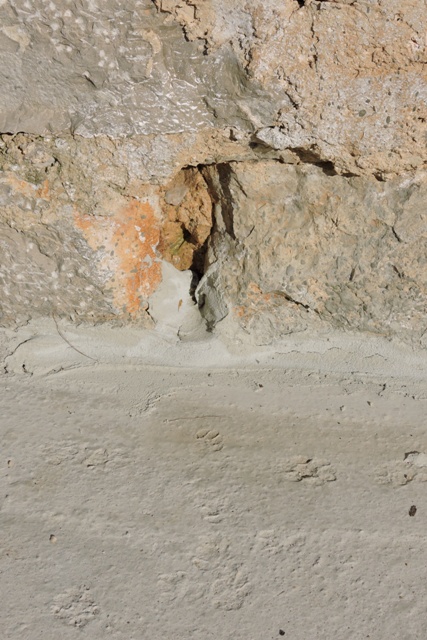
The Mediterranean weather pattern is that winter’s are mild and wet and summers are hot and dry.
Although the received wisdom is that the winter rainy season is from November to February, I’ve noticed that from September we can get wet weather. I am sure that this quick intervention will have done the trick.
All I had to so was leave the doors and windows of the workshop open to dry out the damp patches on the walls.
The last Kiwanos
I’ve not attempted to grow Water Melons because I simply do not have enough soil moisture for them, but I have had some success with honeydew melons.
This year I tried Kiwano melons, Cucumis metuliferus, also known as horned melons.
The plant thrives in hot dry climates, although it does prefer a soil with a slightly acid Ph, where as my soils are generally alkaline. But with some added peat, I have found a corner in the Top Orchard that it seems to like.
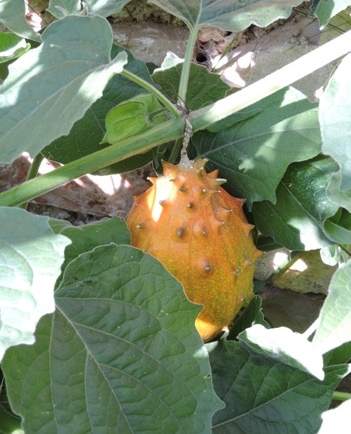
I still have some flowers on the vine, but they are not going to produce any more fruit this year.
The taste is like a passion fruit and it is lovely as part of a yogurt smoothie. The peel is also edible and has a very high content of vitamins, minerals and fibre.
Whereas green in nature usually means something is unripe, in Kiwanos, green means it is ready to eat.

The last two are now in the kitchen, ready to be turned into smoothies, to be added to some Passion fruit in the smoothie maker.
If you want to try them, save a few seeds from a supermarket bought fruit, then plant next spring. NCG